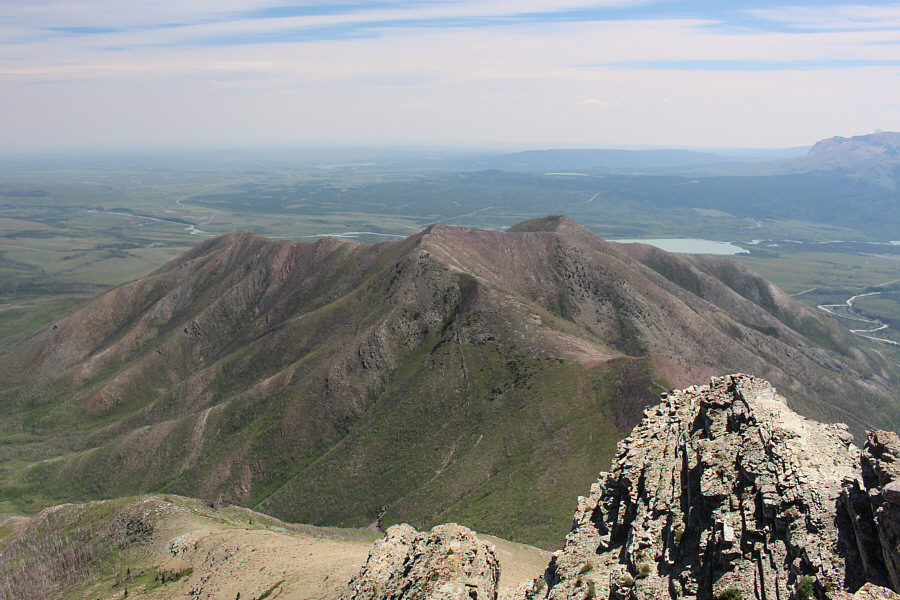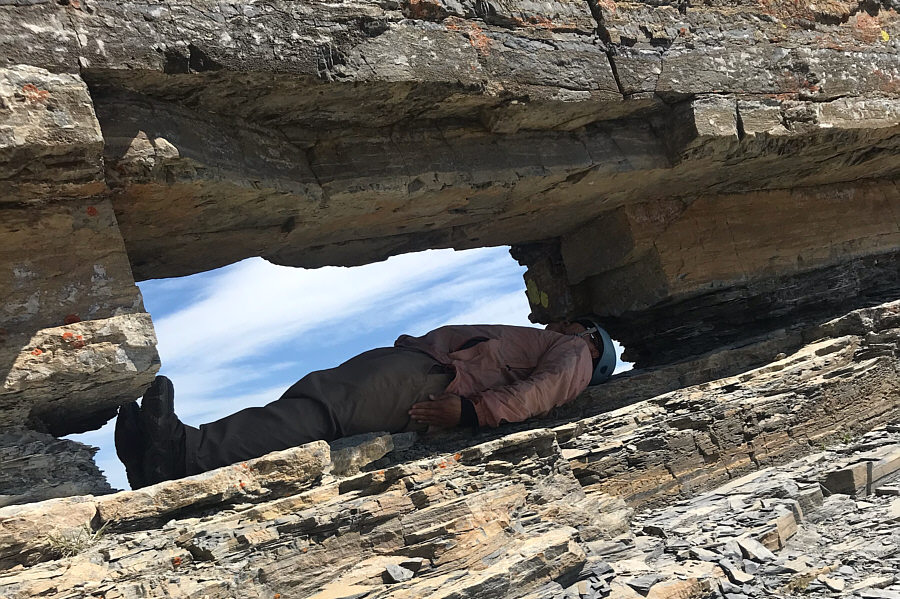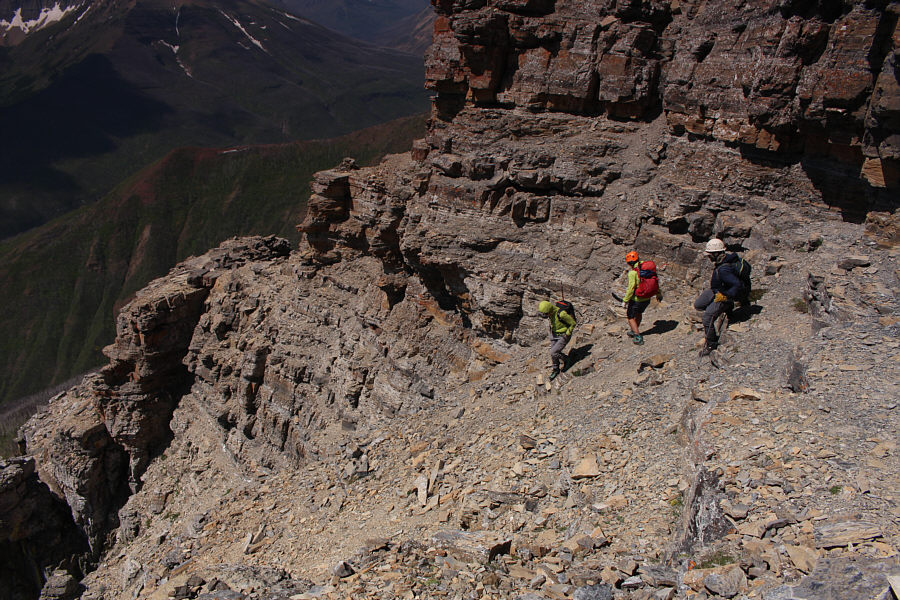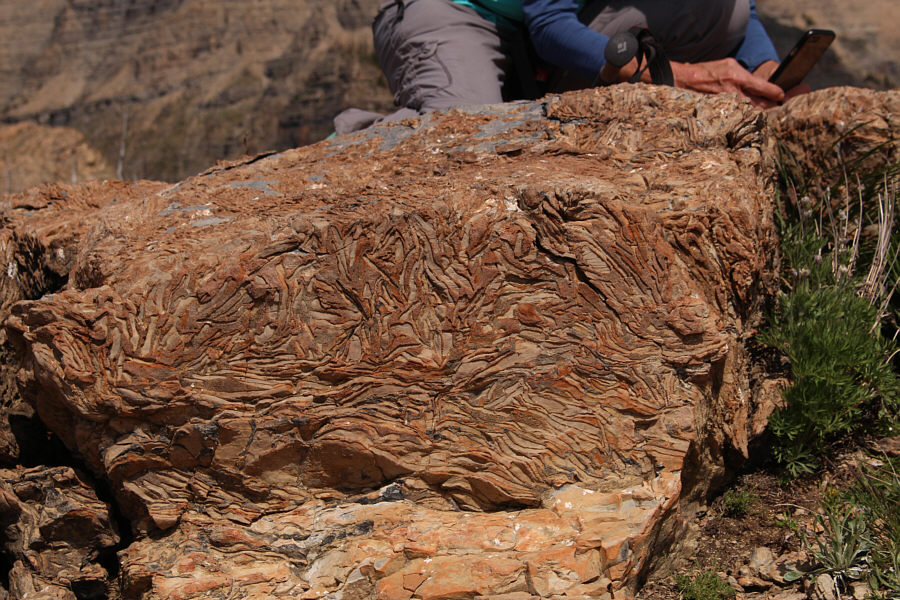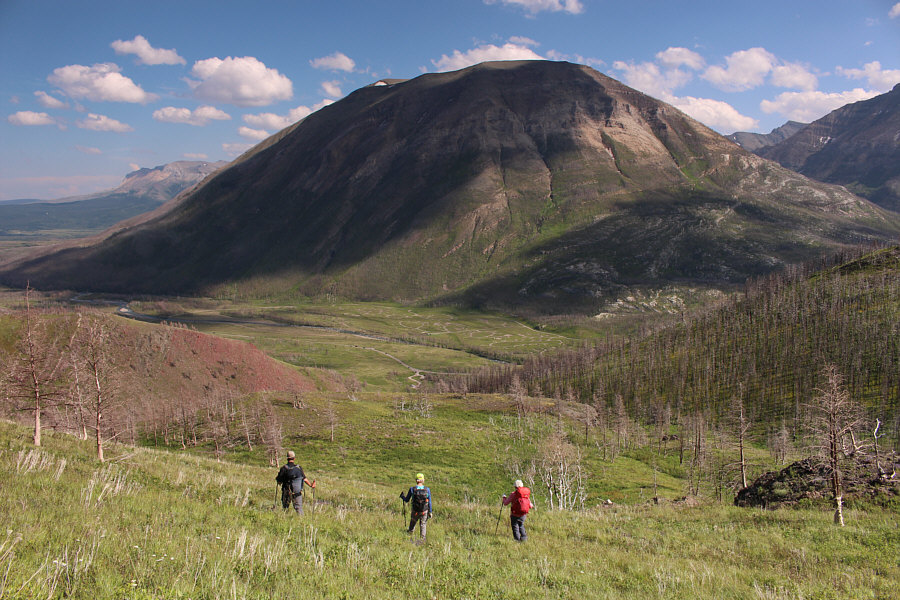BOU AVENUE
Mount Galwey North Summit
On 4 July 2020, Alda Sigvaldason invited me
to join her for an ascent of the north summit of Mount Galwey in
Alberta's Waterton National Park. A route description for this
extension to the scramble up Mount Galwey can be found in the 3rd edition
of Alan Kane's Scrambles in the Canadian Rockies. Having already
climbed the gazetted summit of Mount Galwey in
2005, I was
admittedly a little hesitant about a second visit to the
mountain, but since the north summit would be new terrain to me, I felt
that there was some merit for a return trip especially since the weather
forecast promised to be fantastic. Besides, it was a good
excuse to visit Waterton National Park again since I was last there in
2016, and I
was curious about the state of the park in the wake
of the Kenow wildfire which had ravaged much of the area in
2017.
Joining us on this excursion were Alda's friends, Jeannine Martel and
Brian Pinter.
Starting from Coppermine Creek picnic area
(no toilets--likely destroyed in the wildfire), we picked up an unmarked
trail and started climbing quickly up the approach ridge for Mount Galwey.
Jeannine, Brian and Alda are all very fit, and I had a tough time keeping
up with them all day. Although trees were already sparse on the
approach ridge, all of them had been scorched and left as lifeless
trunks. We would see more of these later in the day. On the
south face of Mount Galwey, we chose to ascend an obvious water-worn
gully instead of Kane's diagonally-rising scree trail. The gully
entails some easy hands-on scrambling which is probably better than the
drudgery of grinding up the scree trail, but higher up, we had to
traverse to climber's left anyway to regain Kane's route on the southwest
ridge. Unlike in 2005 when I had the whole mountain to myself, on
this day there were probably some two dozen scramblers--some better
equipped than others--slithering up and down Kane's route. Rockfall
was a serious possibility in the steep gully leading to the crux, but
everyone I encountered seemed very conscientious about the hazard and
were careful not to dislodge rocks onto each other. The crux is a
short, exposed traverse to reach the bottom of a chute next to a natural
window. Fortunately, the ledges here are still as solid as they
were in 2005, and we had no serious problems with the traverse. A
short scramble up the chute brought us to the crowded top of Mount Galwey.
Sadly, the summit register canister that had been there in 2005 was
missing (I left a new register booklet that day with a politically
incorrect limerick to boot). We took about a 20-minute break on the
summit before dropping down to take a closer look at the celebrated
natural window. We then retreated back across the crux and dropped
down further to about 50 metres below the top before beginning the
traverse to the north summit.
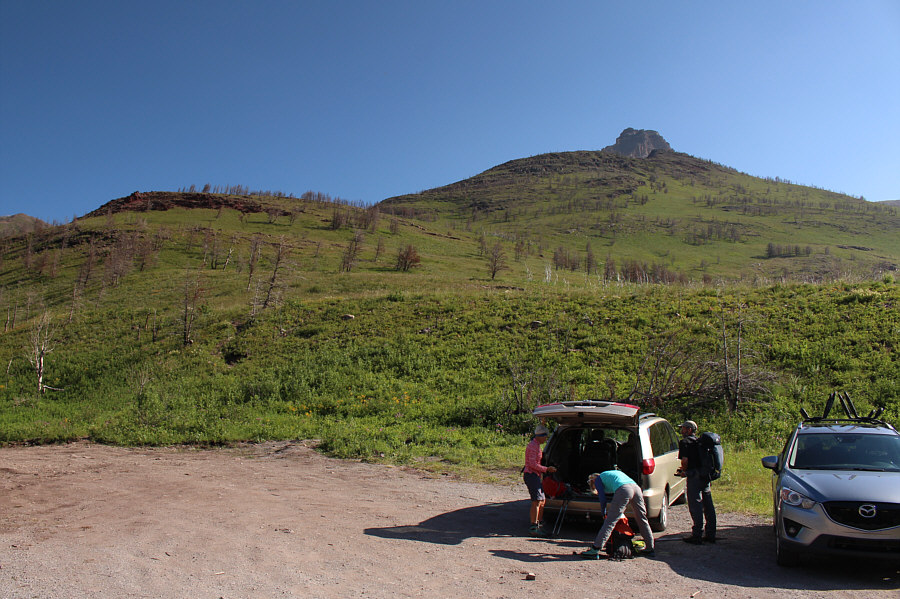 |
The group gears up at the Coppermine
Creek trailhead. The top of Mount Galwey is peeking over the
approach ridge. |
 |
The group follows a trail up the
approach ridge. |

Here is one of the first views of Mount Galwey's north
summit (left).
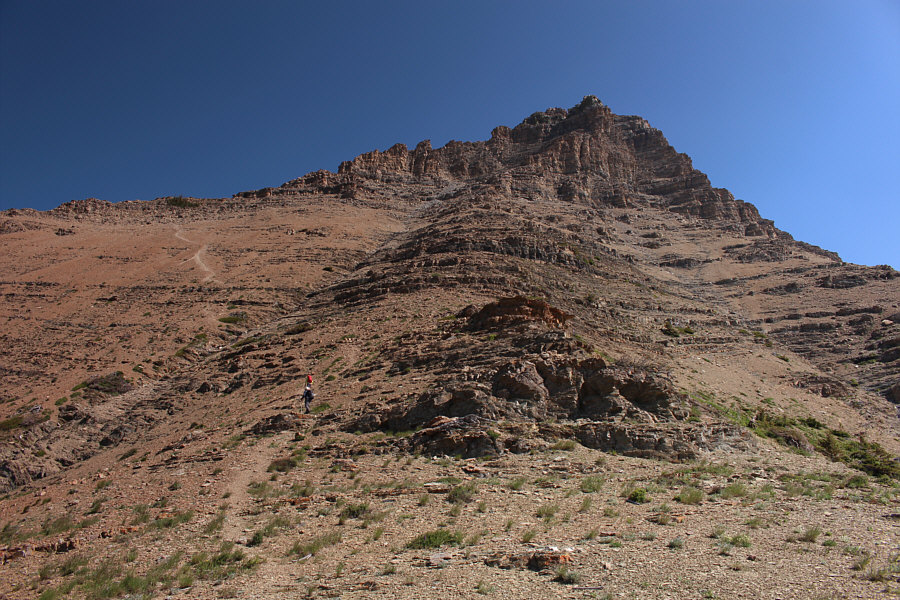 |
The group begins to climb up Mount
Galwey's south face. Note the obvious water-worn gully at left. |
 |
The group ascends the water-worn
gully. |
 |
The group traverses across loose scree
to regain Kane's ascent route. At left is
Mount
Blakiston, the highest peak in Waterton National Park. |
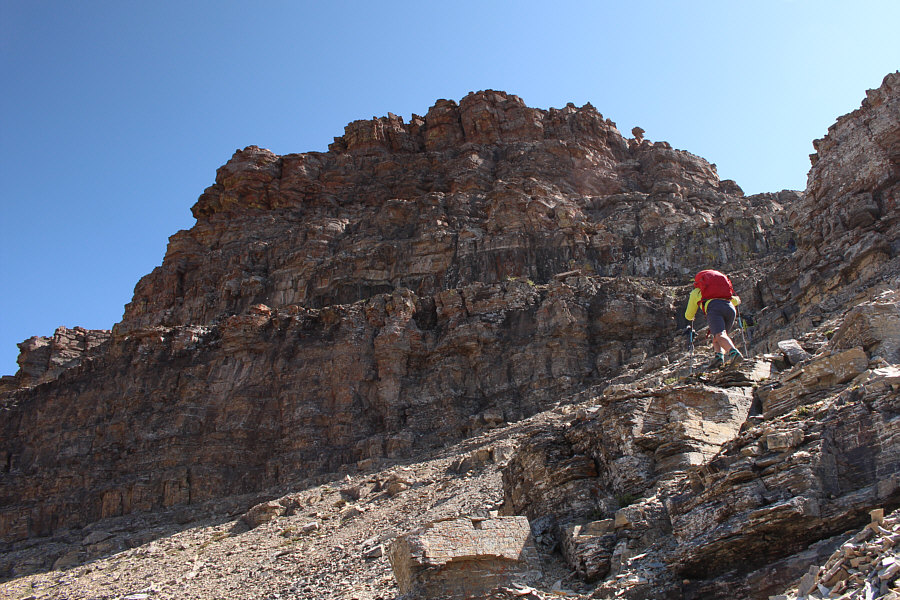 |
Alda follows Brian up a steep gully
leading to the top of Mount Galwey. Note the rock resembling a
mushroom (upper right) which is a key landmark mentioned by Kane. |
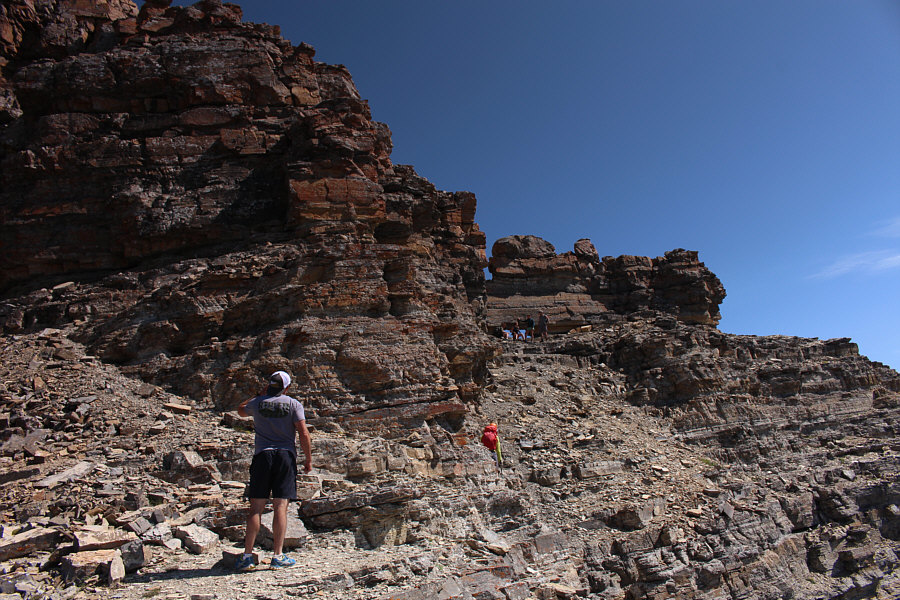 |
This is the exposed traverse (crux)
mentioned by Kane. Some hikers can be seen congregating in
front of the natural window which is also mentioned by Kane. |
 |
Brian scrambles up a steep chute just
below the summit. |
 |
Alda comes up the same chute. |
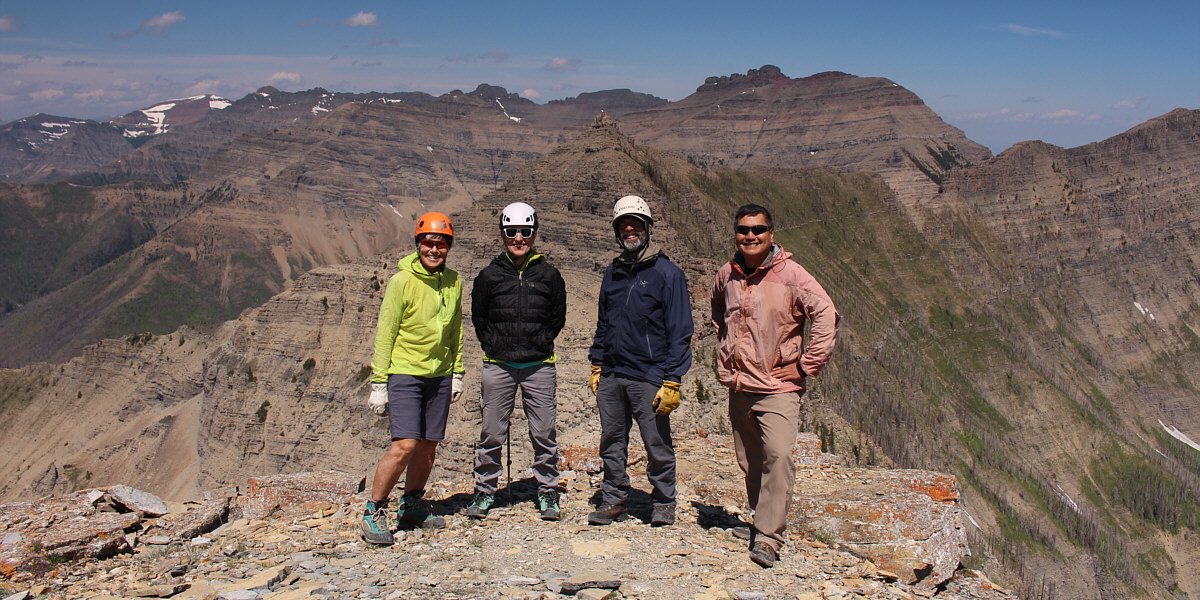
Alda, Jeannine, Brian and Sonny stand on the gazetted
summit of Mount Galwey (2376 metres).
En route to the north summit, we followed Kane's advice and
generally stayed below the crest of the connecting ridge. The
sidehill-bashing on rubble-covered ledges was somewhat tedious but not
nearly as bad as I was expecting. As we passed the base of the
cliffs below the north summit, we began looking for weaknesses to
scramble upward. The further to climber's left we went, the more
options presented themselves to us, and after another round of moderate
scrambling, we were standing atop the north summit of Mount Galwey.
The traverse between the two summits took us about an hour, and since we
had the north summit all to ourselves, we took a much longer break here
to enjoy the surrounding views.
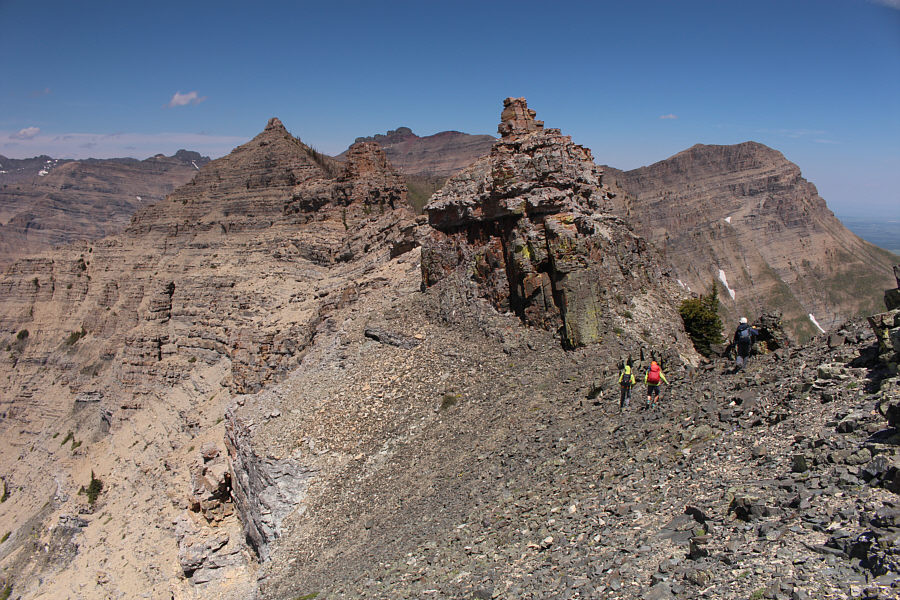 |
The group needs to bypass a couple of pinnacles en route to the north
summit of Mount Galwey. |
 |
The group waits for Sonny to catch up. Behind them is Anderson
Peak. |
 |
Here is an unusual perspective of Mount Galwey from partway along the
traverse to its north summit. Note the figures at lower right. |
 |
The sidehill-bashing to get to the north summit is tedious but not bad. |
 |
The group looks for a weakness in the cliff bands guarding the north
summit. |
 |
The group starts scrambling up moderate terrain just below the north
summit. |
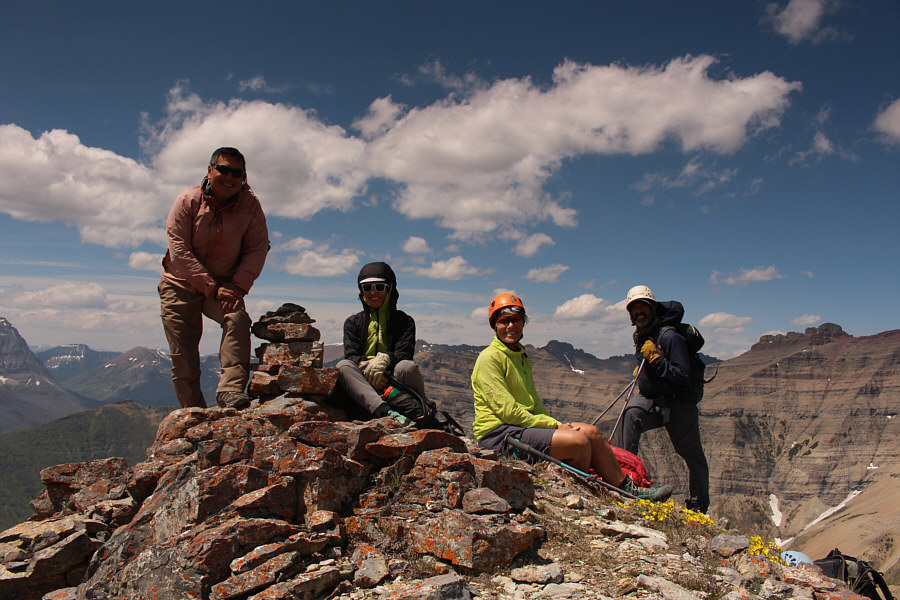 |
Sonny, Jeannine, Alda and Brian reach
the top of Mount Galwey's north summit (2385 metres). |
 |
Here is a look back at the gazetted
summit of Mount Galwey. |
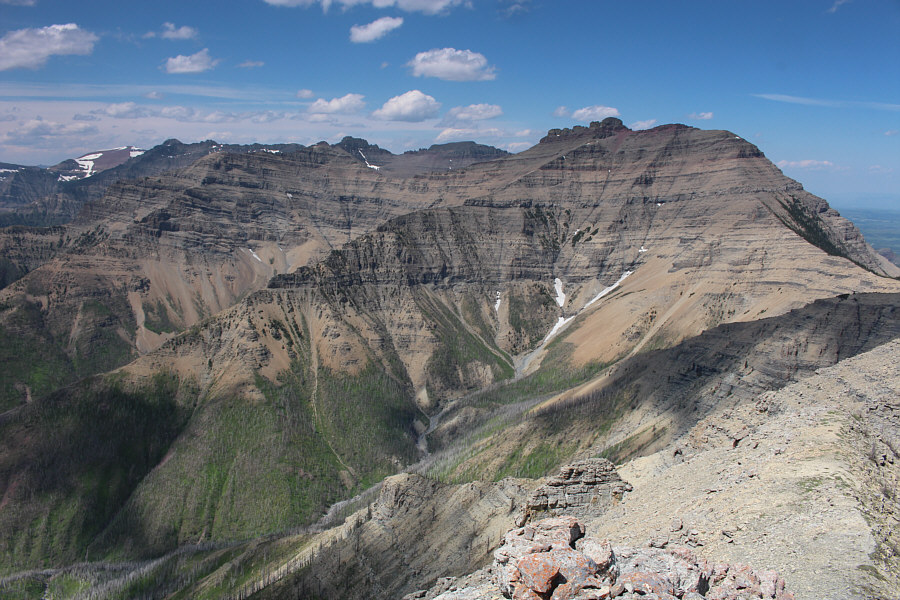 |
Visible to the northwest are Glendowan
Mountain (left), Cloudy Ridge (centre), and Mount Dungarvan (right). |
 |
The next high point to the north is
known locally as "The Horn" (as indicated on an interpretive sign
along Highway 6) but has recently been dubbed "Dunwey Peak" and then
"Rogan Peak" by Andrew Nugara. |
For our return, we opted to do the loop suggested by Kane by
descending the ridge west of the north summit. The terrain below
the summit is steep and loose, and it was a bit tricky to descend here in
a group without sending a hail of rocks down on each other. We
could relax a bit once we muddled our way over to the crest of the west
ridge, but there are a couple of drop-offs further down that proved
problematic. I was able to find a way for us to down-climb the
first drop-off directly, but the second drop-off proved to be a bit too
unnerving to attempt. Instead, we had to backtrack slightly and
descend, with some difficulty, a weakness on the south side of the ridge.
A bit of sidehill-bashing allowed us to circumvent the second drop-off
and resume our descent along the crest of the ridge. The ridge
eventually turns southward flanking the west side of Coppermine Creek,
and although we began to see more scorched trees lower down, there was
surprisingly not a lot of ankle-breaking deadfall to trip us up.
Near the end of the ridge, we had some discussions about whether or not
we should drop down into Coppermine Creek and follow the drainage out to
the trailhead. Ultimately, we dropped down far enough to take a
peek and decided that it was better to stay higher up on the bank.
We endured another few hundred metres of sidehill-bashing until we were
nearly across the creek from the trailhead. We completed our loop
with an easy rock-hop across the creek followed by an inconsequential bushwhack.This trip exceeded my expectations and turned out to be a
lot of fun. Certainly, the fabulous weather helped, but as always,
it is all about sharing the triumphs and tribulations on the trail (or
off-trail) with great company. I want to thank my companions for
all the intriguing discussions throughout the day and for their patience
and understanding. It is not easy to hike with a slowpoke like me!
A special thank you goes to Alda for inviting me and for driving us all
in her minivan; being able to relax in a comfortable back seat after a
long hike was heavenly for me!
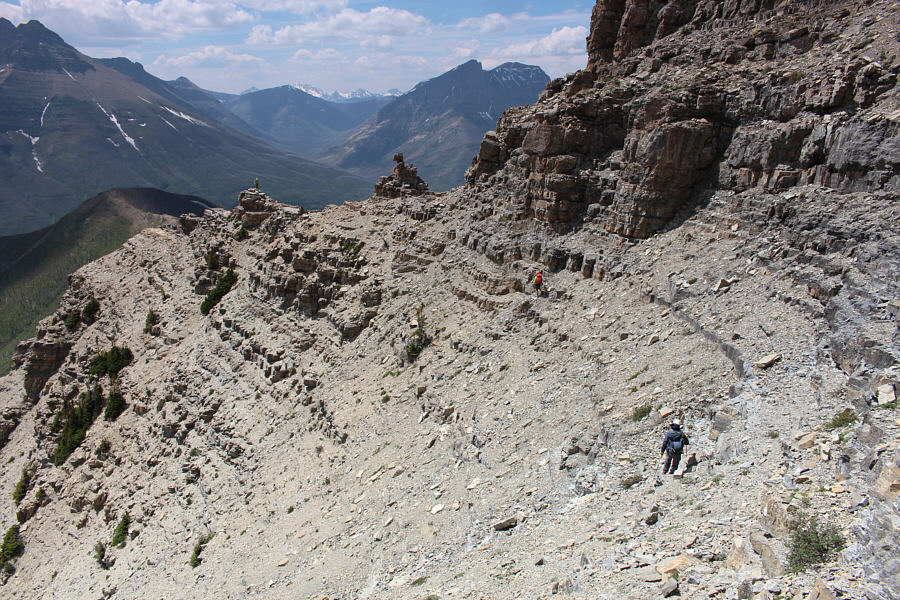 |
The group carefully makes its way to
the ridge west of the north summit. |
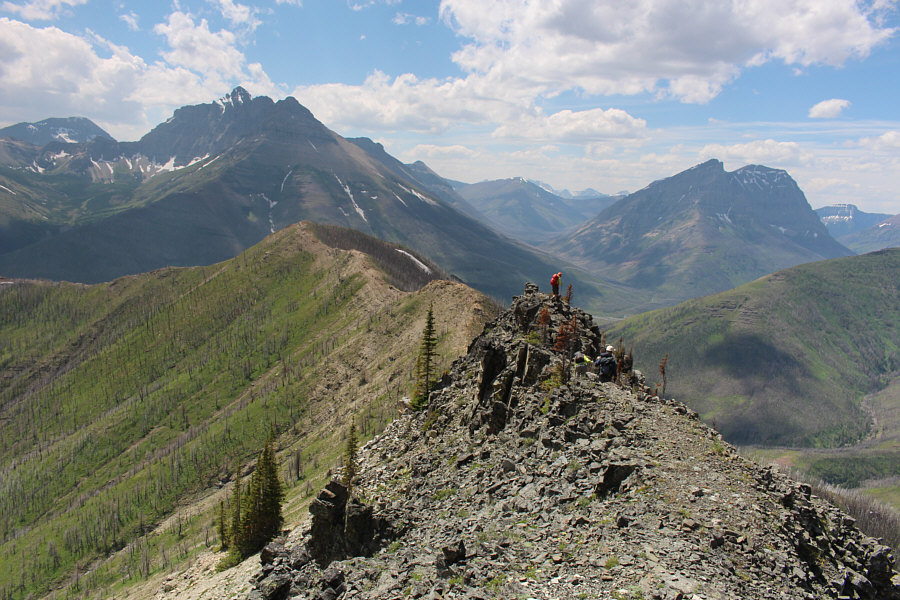 |
The group gains the crest of the west ridge which can be seen curving to the left (south) in
the distance. |
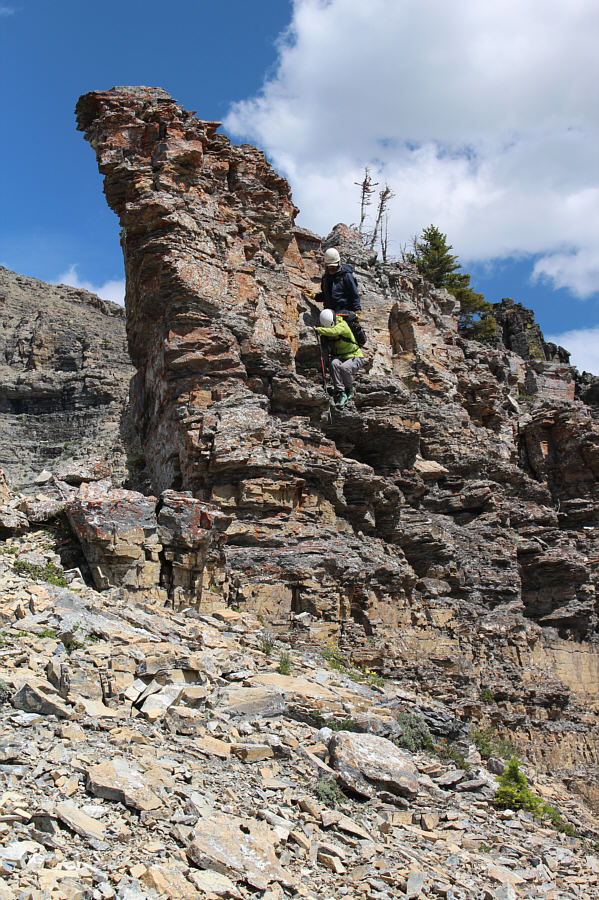 |
Jeannine and Brian down-climb the
first of two steep drop-offs along the west ridge. |
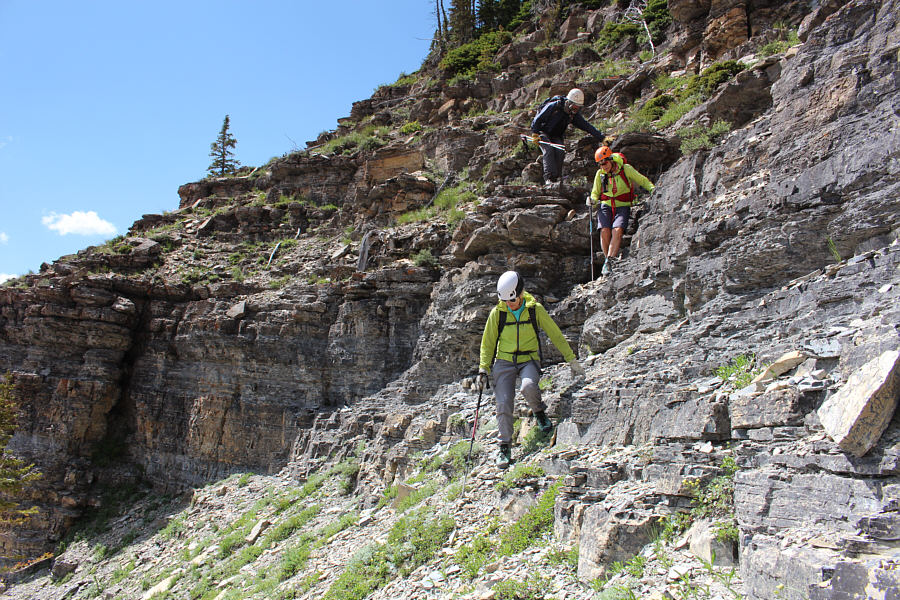 |
The group finds an alternate route to
bypass the second drop-off (not visible here) along the ridge. |
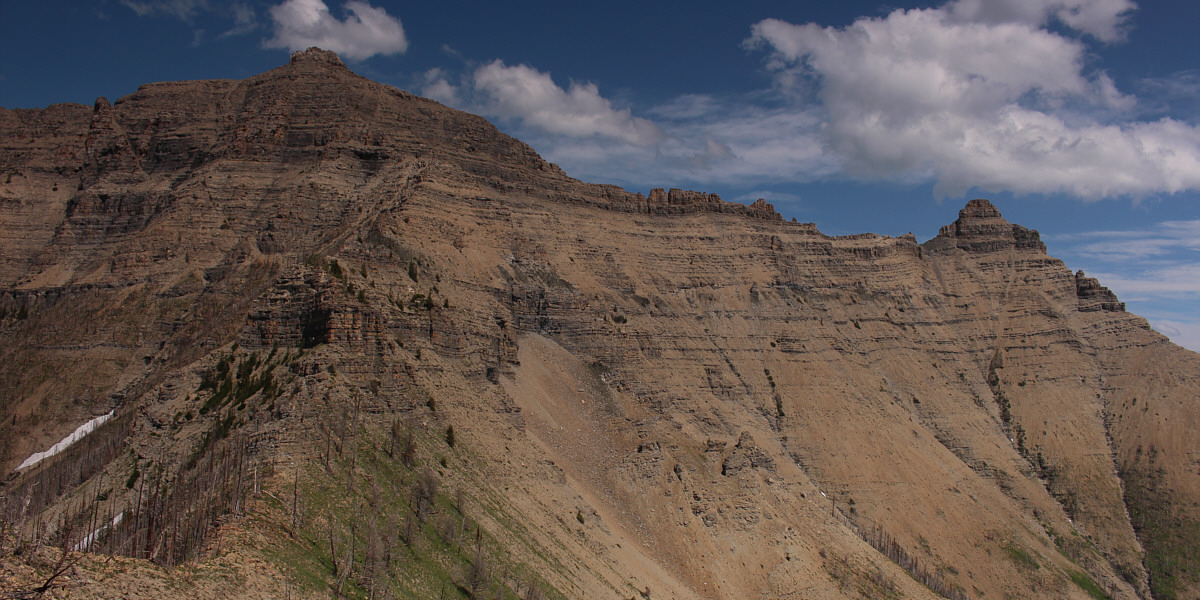
As seen from the west ridge, this a comprehensive view of Mount Galwey (right)
and its higher north summit (left).














